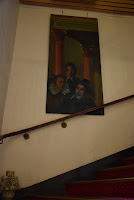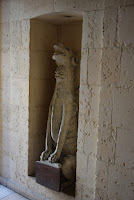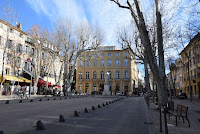I reached Marseille fairly early in the morning having taken a bus direct to Aix-en- Provence where I had intended to spend the long weekend.
From the Bus terminal I walked up Rue des Alumettes, where the Grand Thêatre de Provence was located, so as to reach the Hotel Artea. Feeling the cosy atmosphere of the lodging I hesitated to go out straight away though I ended up forcing myself particularly because I had planned to visit the Museum Granet.


The outside luminosity was rather exquisite and despite the cold it felt like a Spring day. I had read about the numerous street fountains and in no time came across the huge 1860 Fontaine de la Rotonde with its three imposing statues representing Justice (looking towards the city), Agriculture towards Marseille and Beaux Arts Avignon.

Soon after as I was heading to Place Géneral De Gaulle I came across a statue representing Cézanne, which instinctively reminded me of the importance Provence had on a number of painters.

Cours Mirabeau, connecting the old city with the Mazarin quarte,r was clearly at the centre of the city bustling. I had never imagined I'd come across such a beautiful leafless tree lined pedestrian avenue with quite a few fountains and majestic 17th and 18th century buildings, amongst which I would highlight the Hotel Maurel de Monteves because of its magnificent façade.




Before turning into Rue d'Italie one could see the imposing statue of the "good King René", King of Naples and Sicily, Duke of Bar, Anjou and Lorraine, as well as Count of Provence (1434-1480), whose role was noteworthy.


On the right hand side stood the 1695 Chapel of the Oblats de Marie, which formerly pertained to the order of the Carmelites' convent. What impressed me most was the light that came out from the oval dome and a rather interesting cribb with small figures from the various continents.
















No comments:
Post a Comment